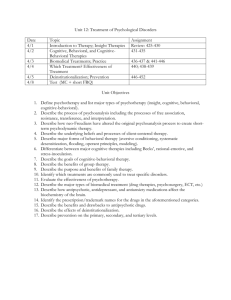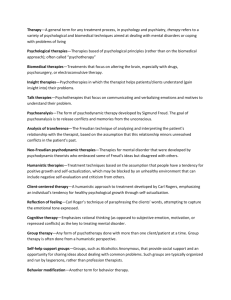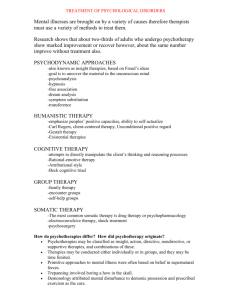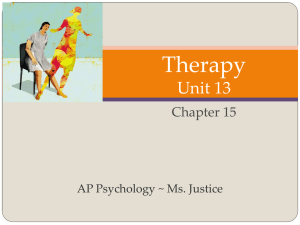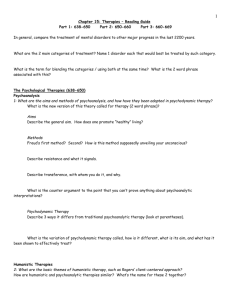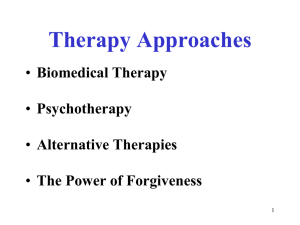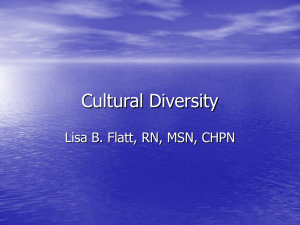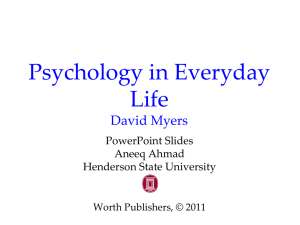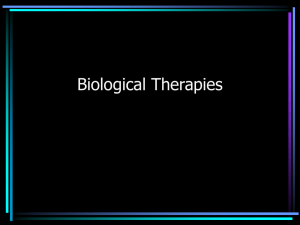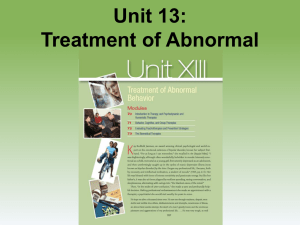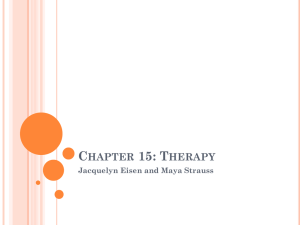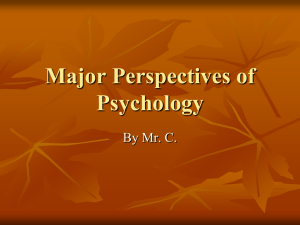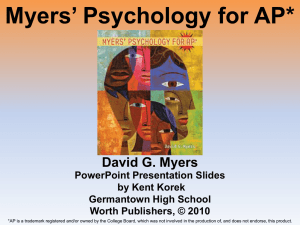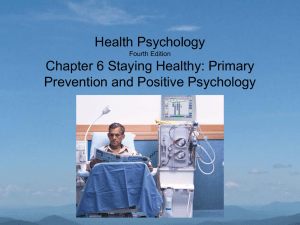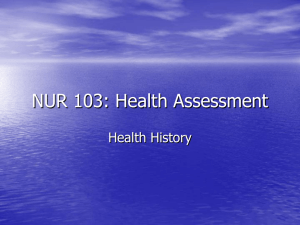Psychological Therapies - Cabarrus County Schools
advertisement
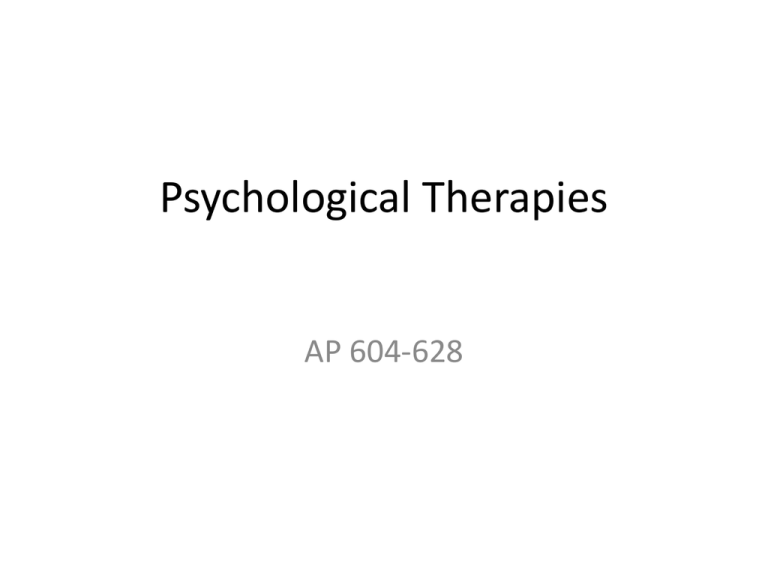
Psychological Therapies AP 604-628 Therapy • It used to be that if someone exhibited abnormal behavior, they were institutionalized. • Because of new drugs and better therapy, the U.S. went to a policy of deinstitutionalization. 2 Major Types of Therapy • 1. Psychological Therapies: employ interaction (usually verbal) between trained professional and a client with a problem VS. • 2. Biomedical: therapies directed at a patient’s nervous system. Eclectic Approach Takes a Smorgasbord Approach • Eclectic Approach: uses a variety of different techniques from various theories of therapy depending on the problem of the individual. • More than half of therapists take this approach. Behavior Therapies • View psychological disorders as learned behaviors to be fixed by learning new behaviors (not searching for underlying causes) • Based upon Behaviorist and Social-Cognitive approaches to personality/disorder Behavior Therapies Behavior Therapy – applies learning principles to the elimination of unwanted learning Utilizes both classical and operant conditioning Classical Conditioning Counterconditioning – uses classical conditioning to evoke new responses to stimuli that are triggering unwanted behaviors. 1. Exposure Therapy 2. Systematic Desensitization Exposure Therapies – behavioral techniques that treat anxieties by exposing people to things they may fear and avoid. Exposure Techniques • “Flooding” – Based on extinction – Keeps people in feared (but harmless) situation and prevents them from normally rewarding pattern of escape – Association between feared stimulus and fear response gradually weakens Classical Conditioning Systematic Desensitization – a type of counter conditioning that associates a pleasant relaxed state with gradually increasing anxietytriggering stimuli (Developed by Joseph Wolpe) Used to treat phobias Virtual reality exposure therapy progressively exposes people to their greatest fears Behavioral Therapies: Counterconditioning/Exposure Therapy • Step 1: Learn relaxation techniques • Step 2: Create a hierarchy of what you fear • Step 3: Engage each level of the hierarchy while using relaxation techniques Less Aggressive Exposure Therapy (Not in Book) • Implosion: patient imagines stimulus rather than being exposed to actual negative stimulus…hopes to reduce anxiety. • Usually used as first step in systematic desensitization. Behavioral Therapies: Counterconditioning Aversive Conditioning: a type of counterconditioning that associates an unpleasant state (such as nausea) with an unwanted behavior (such as drinking alcohol) Will eventually lead to extinction Operant Conditioning Operant Conditioning therapy has been used to help those with Autism Token economy – conditioning procedure that attempts to modify behavior by giving rewards for desired behaviors. The tokens can later be exchanged for privileges or treats. Parents, schools, daycares, hospitals all use this token economy idea Behavior Affects Biology • Biofeedback: uses a system that records physiological processes such as heart rate, muscle tension, and skin temperature. • Patient can use immediate information to see degree which they can change anxietyrelated responses to lessen physiological arousal. Biomedical Therapy • Prescribed medications or medical procedures that act directly on the patients nervous system. – Drugs that alter brain chemistry – Affecting brain circuitry with electric shock, magnetic impulses, or psychosurgery. Drug Therapies • Psychopharmacology = study of the effects of drugs on mind and behavior. – Drugs have minimized involuntary hospitalization. • Why is this a good thing? • Why is this a bad thing? Antipsychotic Drugs • Antipsychotics are drugs used to treat people with psychoses – Psychoses is a break in reality where people experience hallucinations or delusions. – Dampen responsiveness to irrelevant stimuli. – Antagonist for Dopamine – Can cause sluggishness, tremors, and twitches because of the low dopamine levels. Drug Treatments: Antipsychotics (Neuroleptics) • Antipsychotics are used to treat psychotic disorders like schizophrenia. • Antipsychotics helps those experiencing both positive and negative symptoms. • Most Common Examples: – Thorazine: alleviates delusions/hallucinations (positive symptoms). – Clozaril: alleviates negative symptoms and social withdrawal. Also prescribed for those at risk for suicide. Long Term Use of Antipsychotics • Tardive Dyskinesia = Involuntary movements of the facial muscles tongue and limbs. • Negative side effects – Nausea – Headaches – Exacerbation of other medical problems Antianxiety Drugs • Drugs used to control anxiety and agitation. – Depress central nervous system activity by increasing the amounts of GABA in the brain. – Xanax • Can become physiologically dependent. Antidepressant Drugs • Drugs used to treat depression or anxiety. Different types work by altering the levels of various neurotransmitters. – Norepinephrine – Serotonin • SSRI: Prozac, Zoloft, Paxil – Can have serious side effects – Full effect of the drug may take up to four weeks Drug Treatments: Mood Stabilizers for Bipolar Disorder • Most common is the salt lithium (carbonate) is most frequently used to treat the mood swings of bipolar disorder. • Decreases adrenaline and increases serotonin. • Often can have dangerous side effects including being toxic at high doses Drug Treatments: Stimulants • Stimulants are often used to treat AttentionDeficit/Hyperactivity disorder (ADHD): a common problem for children who have difficulty controlling their behavior and focusing their attention. • Although its exact mechanism is unknown the stimulants have a calming and focusing effect in children by increasing neurotransmitters associated with such processes. Antidepressants and the Placebo Effect • 75% of antidepressants effects can be contributed to the placebo effect. • The placebo effect was less for those who had sever depression. – Evidence many use to make the argument we should only be using antidepressants in sever cases after other therapies have failed. • 1 in 4 people do not respond to a particular antidepressant and switching to another usually brings relief. Electroconvulsive Therapy (ECT) • Electroconvulsive Therapy: used to treat the severely depressed after other treatments have failed. • Success rate is high. ECT • Introduced in 1938 • 100 volts of electricity for 30-60 seconds. • Today patients receive general anesthetic and muscle relaxants. • Some memory loss is common. • We do not know why or how it works. Biomedical Therapy • Repetitive Transcranial Magnetic Stimulation: the application of repeated pulses of magnetic energy to the brain; used to stimulate or suppress brain activity Alternative Neurostimulation Therapies • Deep-Brain Stimulation: Focuses on stimulation an area of the brain that connects the frontal lobes and the limbic system. Psychosurgery • Surgery that removes or destroys brain tissue in an effort to change behavior. • Lobotomy = A procedure that cut the nerves connecting the frontal lobes to the emotion-controlling centers of the inner brain. – Created permanently lethargic personality. http://www.npr.org/templates/story/story.php?storyI d=5014080 Psychosurgery is Most Drastic Intervention lobotomy: Ice pick like instrument is put through the eye sockets cutting the links between the frontal lobes and the emotional control centers. Used to be used to “cure” uncontrollably violent patients but now very rare. Lobotomy • Therapeutic Life-Style Change • Aerobic Exercise helps to calm those with anxiety disorders and energize those who feel depressed. • Adequate sleep (7-8 hours a day) can increase energy and alertness. • Light exposure amplifies arousal and influences hormones. • Social connections helps to satisfy the human need to belong. • Positive Thinking • Nutritional supplements helps with healthy brain functioning. Cognitive Therapy • Change the way we view the world (change our schemas) • Based on work by Aaron Beck and Albert Ellis Cognitive Therapy Cognitive Therapy – teaches people new, more adaptive ways of thinking and acting; based on the assumption that thoughts intervene between events and our emotional reactions. Our thinking affects how we feel Try to teach people to think constructively as opposed to destructively. Cognitive Therapy Cont’d Cognitive Behavior Therapy – therapy that combines cognitive and behavior therapies. Attempts to alter thoughts as well as the actions Especially effective in treating OCD. This is used as a method to treat most psychological disorders. Cognitive Therapies Rational-Emotive Behavior Therapy (REBT) – Albert Ellis • Assumes psychological problems like anxiety, guilt, depression are caused by how people think about events (not the events themselves) • Aims to identify and change selfdefeating thoughts – (i.e. “shoulds” and “musts”) Cognitive Therapies • Cognitive Therapy – Aaron Beck • Certain disorders (esp. depression & anxiety) can be traced to “cognitive distortions” (errors in logic) – “catastrophizing” – “all-or-none thinking” – “personalization” – Some have a pessimistic outlook, tendency to blame bad events on themselves • Help identify distorted thoughts/beliefs • Treat these as hypotheses to be tested – Often given “homework” – Provides evidence to challenge distortions Most Common Illnesses Treated in Cognitive Perspective • • • • • 1. 2. 3. 4. 5. Depression Eating Disorders Chronic Pain Marital Problems Anxiety Disorders Family and Group Therapy Family Therapy – view’s an individual’s behavior as guided by or directed at other family members; tries to improve communication and relationships. This focuses on relationships and can be used quite often when a child is dealing with a neurological disorder Family and Group Therapy Cont’d Advantages of group therapy: 1. Help more people in less time 2. Lower cost 3. Allows people to discover that others are dealing with similar troubles to their own. This can bring relief 4. Foster a sense of community Humanistic Therapy • Insight Therapy: a therapy which aims to improve psychological functioning by increasing the client’s awareness of underlying motives and defenses Humanistic Therapy • People are capable of consciously controlling own actions, taking responsibility for decisions – Behavior is motivated by drive for personal growth/improvement, guided by way they perceive their world – Disorder comes from blocked growth due to distorted perceptions or lack of awareness of feelings Client-Centered Therapy (aka Person-Centered Therapy) • Developed by Carl Rogers Allows client to decide what to talk about without direction (non-directive therapy), judgment, or interpretation • Less popular model today, but still influences therapy Client-Centered Therapy • Attitudes of therapist: – Unconditional Positive Regard (Acceptance) • Convey caring/value for client as a person, no matter what – Help overcome “conditions of worth” – Listen without interrupting, making judgments, or offering advice – Empathy • Attempt to understand how world looks from client’s point of view (need not approve of everything) – “active listening” – “reflection” – paraphrase client’s statements and note feelings – Genuineness (Congruence) • A consistency between way therapists feel and way they act toward clients – Shows relationships can be built on openness/honesty Humanistic Therapy • Assumptions: 1. Treatment is an encounter between equals (not “cure” by “expert”) 2. Clients improve on own given right conditions (conditions promote awareness, acceptance, emotional expression) 3. Ideal conditions established by feeling fully accepted/supported as human beings 4. Clients remain responsible for choosing how they think/behave Humanistic Therapy Therapy that aims to promote self-fulfillment by increasing selfacceptance and self awareness Differ from the psychoanalytic perspective in 3 ways: 1. Focus on fostering growth instead of relieving illness 2. Focus on the present and future instead of the past 3. Emphasize conscious thought as opposed to the unconscious Psychoanalysis Sigmund Freud – Founder of psychoanalysis Psychoanalysis – Theory of personality and therapeutic technique that attributes our thoughts and actions to unconscious motives and conflicts Classic Psychoanalysis • Freud developed methods in medical work with “hysteria” (conversion disorder) patients – Initially tried hypnosis – not very successful – Came to focus on unconscious and conflicts raging within it • Gain insight to unconscious thoughts/emotions • Interpret and work through ways it motivates maladaptive thoughts/behavior – May take 3-5 sessions per week over several years Psychoanalysis Psychoanalysis is attempting to make a “historical reconstruction” Psychoanalysis tries to find past events that help understand the present 1.Freud used dream interpretation 2. Free association was used by Freud to explore the unconscious mind Psychoanalysis Resistance – In psychoanalysis, the blocking from consciousness of anxietyladen material Interpretation – In psychoanalysis, the analyst’s noting supposed dream meanings, resistances, and other significant behaviors in order to promote insight Psychoanalysis You will work through the past issues through Freud’s idea of transference with the psychologist Transference – the patient’s transfer to the analyst of emotions linked with other relationships Classic Psychoanalysis • Methods: – Eventually asked patients to lie on couch and report whatever thoughts, memories, or images came to mind (free association) • Resistance – when block sensitive material from free association – therapist needs to explore – “Freudian slips” – Latent content of dreams – wishes, impulses, fantasies kept out of consciousness while awake by defense mechanisms – Transference – patients express dependence, hostility, even love toward therapist • seen as unconscious process of transferring childhood feelings/conflicts • analysis of this provides insight Contemporary Psychodynamic Therapy • Very few Freudian psychoanalysts left • Forms of “short-term psychodynamic therapy” more common now – Interpersonal therapy, Object relations therapy, etc. • May involve less time and money, meet face-to-face, de-emphasize the past & id, stress social/interpersonal relationships – Still focus on unconscious and conscious, internal conflicts, and transference analysis Psychodynamic Therapists Psychodynamic therapy – deriving from psychoanalysis • focuses on themes across important relationships, including childhood experiences, and the therapist relationship Criticism of Psychoanalytic Therapy • 1. Built on assumption that repressed memories exist. • 2. Interpretations cant be proven right or wrong. • 3. Is very time-consuming and costly…usually takes several years to achieve insight. Is Psychotherapy Effective? Some researchers believe that two phenomena make psychotherapy seem more effective than it is. 1. The Placebo Effect 2. Regression toward the mean • Tendency for extreme or unusual scores to fall back to the average Effectiveness of Psychotherapy? How do We Evaluate? • Is it therapy that helps people get better or would it occur naturally? • Regression towards the Mean: the tendency for for unusual emotions (depression/sadness) or events to return (regress) toward their average state with time. Effectiveness of Psychotherapy? How do We Evaluate? • In order to test impact of treated vs. untreated, studies using meta-analysis must be used. • Meta-analysis: procedure for statistically combining the results of many different research studies. Ineffective Therapies Research has shown us that some therapies are ineffective • Energy therapies • Recovered-memory therapies • Rebirthing therapies • Facilitated communication • Crisis debriefing Alternative Therapies There are many alternative types of therapy Therapeutic Touch Therapy • Move their hands around a person to push their energy fields into balance. • Many skeptics including James Randi • Not currently accepted as a medical practice Alternative Therapies Cont’d Light Exposure Therapy to treat SAD – Seasonal Affective Disorder This is an accepted practice that appears to give some benefit. The Most Dominant Therapy is the Cognitive Approach Review: Who Conducts Therapy? • Clinical psychologists –Most are psychologists with a Ph.D. and expertise in research, assessment, and therapy, supplemented by a supervised internship. –About half work in agencies and institutions, half in private practice. –May work in conjunction with a psychiatrist. Review: Who Conducts Therapy? • Counseling Psychologists –Marriage and family counselors specialize in problems arising from family relations. –Typically have one of advanced degrees –Pastoral counselors provide counseling to countless people. –Abuse counselors work with substance abusers and with spouse and child abusers and their victims. Review: Who Conducts Therapy? • Psychiatrists –Physicians who specialize in the treatment of psychological disorders. –Not all psychiatrists have had extensive training in psychotherapy, but as M.D.s they can prescribe medications. Thus, they tend to see those with the most serious problems. –Many have a private practice.
